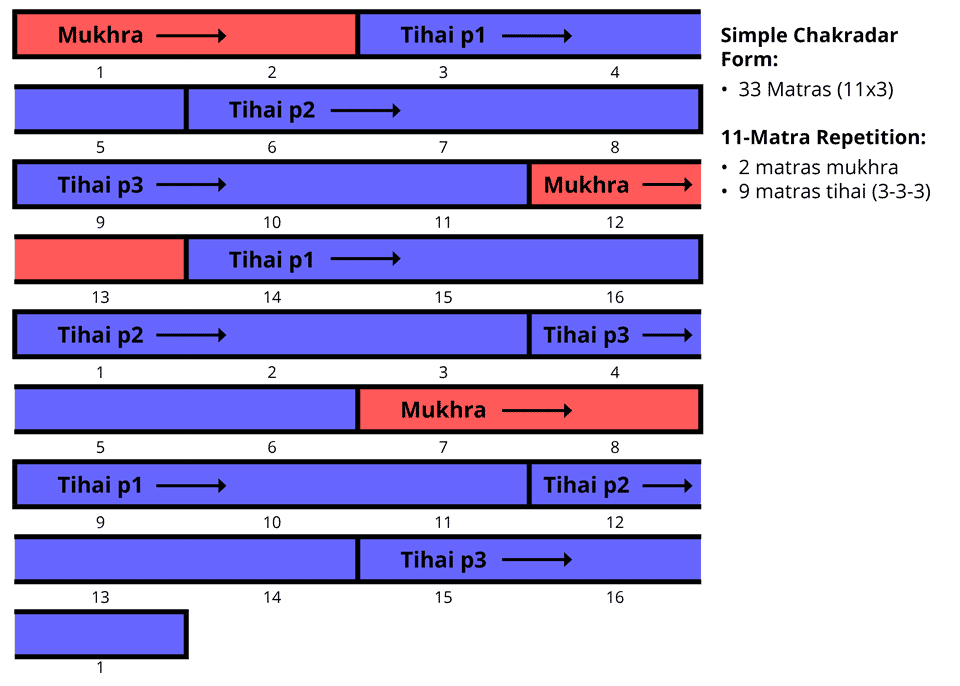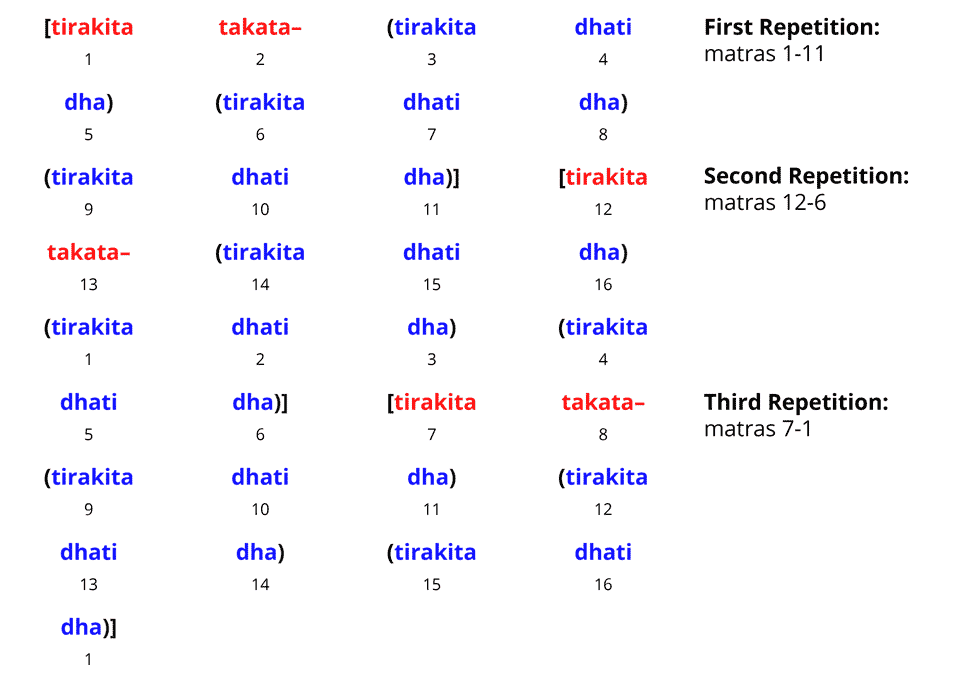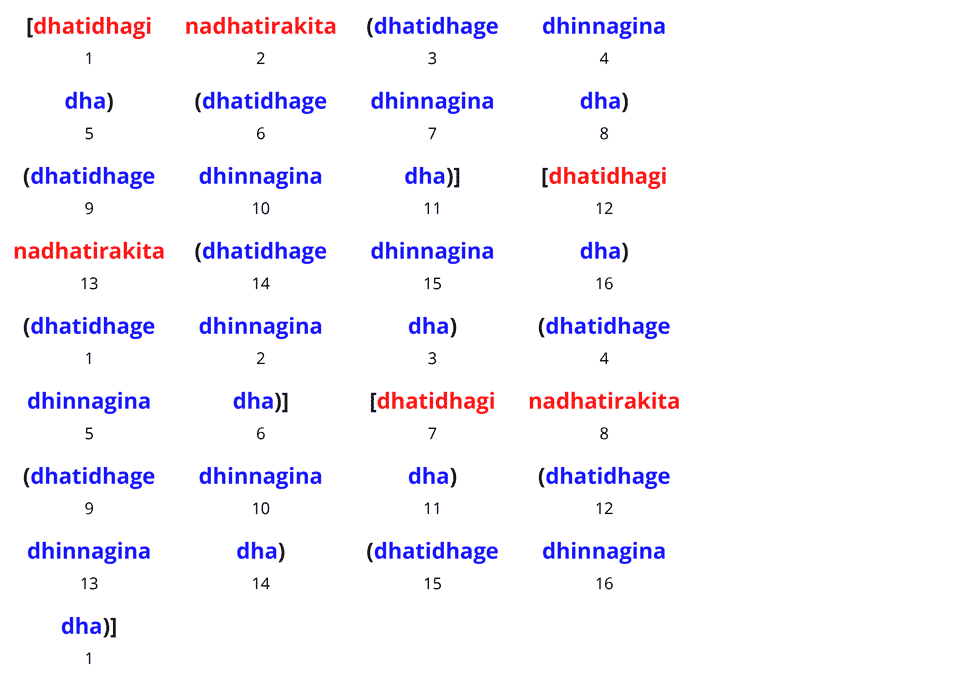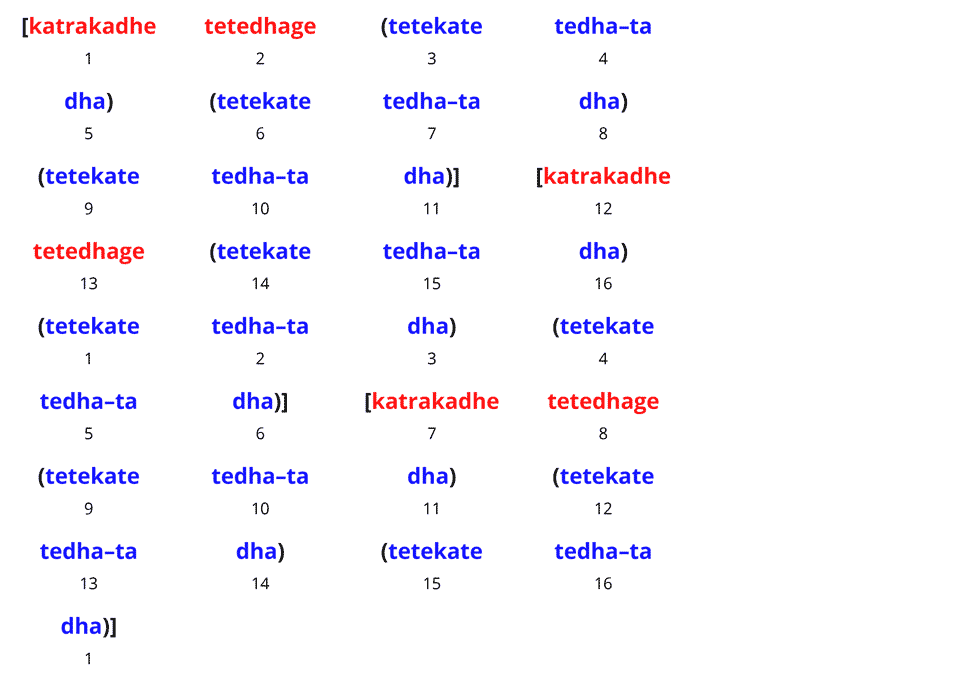Simple Chakradar
Simple Chakradar Characteristics
- Length of chakradar: 33 matras (2 avartans plus sam)
- Length of main repetition: 11 matras
- Length of mukhra: 2 matras
- Length of tihai: 9 matras (3–3–3)
- Length of pause between main repetitions: 0
11-Matra Repetition for the Simple Chakradar:

Full 33-Matra Simple Chakradar:

For an example of this form, here is the simple chakradar made from mukhra that we saw in the Introduction to Chakradar:

Below we will look more closely at how this chakradar is constructed.
About the Simple Chakradar Form
This chakradar form does not have a proper name that I know of. But it is the most common and simple kind of chakradar form. So we will refer to it as the Simple Chakradar.
This particular form is often used to make tihais for kaydas and relas, or to end an improvisation in accompaniment. It is also used for short chakradar tukras.
Like most chakradar forms, this form can be modified (we will look at variations below). But students will hear, and play, this particular version of the simple chakradar very often.
Simple Chakradar Mathematics
For the simple chakradar (or any other chakradar), tabla players will think about two general areas of math:
- Overall math of the chakradar
- Internal math of each repetition
For the overall math of the chakradar, we need to know:
- Length of chakradar
- Length of main repetition
- Length of pause between repetitions
For the internal math of each repetition, we need to know:
- Length of mukhra (opening)
- Length of tihai
- Length of pause between tihai repetitions
Length of the Chakradar
The first thing to know is the length of the chakradar:
- How many matras (beats) is it?
- If it begins on sam (1 of the tal), how many avartans (rounds of the tal) does it last?
All of the chakradar forms we will look at here begin on sam. So when we count avartans, we always add up the matras in the avartans and then add 1. This is because we always end on sam of the next avartan.
The simple chakradar lasts for two avartans of tintal plus sam, for a total of 33 matras. So the math is:
2 x 16 = 32 + 1 = 33
Length of the Main Repetition
After we know how long a chakradar is, then we can know the length of each repetition. To do this, we divide the length of the chakradar by three because all chakradars have three main repetitions.
Our simple chakradar length of 33 matras divides evenly by 3:
33 ÷ 3 = 11
When the total does not divide evenly by 3, then we need to add pauses between repetitions (we will look at this in other chakradar forms). The simple chakradar divides evenly, so the pause is 0.
For our simple chakradar, then, the first important numbers are:
- Length of chakradar = 33
- Length of repetition = 11
Now we have to look at the mukhra-tihai division of the main repetition.
Length of Mukhra and Tihai
In the most common structure of the simple chakradar, the mukhra and tihai are divided as 2 matras of mukhra plus 9 matras of tihai (3–3–3), giving us a total of 11:

To make this structure of 11, we always begin with a 5-matra phrase. This 5-matra phrase is then divided into two smaller phrases: A (2 matras) and B (3 matras):

We then use A for the mukhra, and repeat B three times for the tihai:

Below we will use this formula to create simple chakradars from a few different 5-matra phrases.
Simple Chakradar Examples
Below, we will look at three different simple chakradar examples:
They all use the 11-matra repetition that we saw above: 2 matras of mukhra plus 9 matras of tihai (3–3–3).
Simple Chakradar from Mukhra
Let’s look again at the simple chakradar that we saw above. For this example, we used a 5-matra mukhra (from Mukhra 4.2):

Then we divide this phrase into A (matras 1–2) for the mukhra, and B (matras 3–5) for the tihai:
- A: tirakita takata–
- B: tirakita dhati dha (x 3)
That will give us our 11-matra repetition:
We then repeat this 11-matra phrase three times for the full chakradar:

And here is the same chakradar accompanied by lahra (electronic) [def]. The tintal theka is played for one round before beginning the chakradar:
Simple Chakradar from Kayda
We can make the same simple chakradar form from a kayda. The simple chakradar, in fact, is a common way to end a kayda performance in tabla solo, or in practice.
For an example, we will use a famous Dilli kayda. If you do not know this kayda, I recommend that you at least listen to the theme a few times:
For our 5-matra phrase, we can use the main bol (theme) plus dha (shown here in 4x speed):

To make the 11-matra repetition, we can use matras 1–2 as mukhra, then use matras 3–5 for the tihai:

We then play this repetition three times to make our chakradar:

Full chakradar with lahra:
Simple Chakradar Tukra
Below is a chakradar tukra using the simple chakradar form. It too begins with a 5-matra phrase:

11-Matra Repetition:

Full Chakradar:

Summary
The simple chakradar form has two characteristics which are always the same:
- Length of chakradar (33 matras)
- Length of repetition (11 matras)
And the standard mukhra-tihai division for the 11-matra repetition is:
- 2 matras of mukhra
- 9 matras of tihai (3-3-3)
The simple chakradar form presented here is very common, and is a standard for students in their practice.
Other Simple Chakradar Examples
The following compositions include the simple chakradar in their variations:
- Benares Kayda 8
- Benares Kayda 9
- Benares Kayda 14
- Dilli Beginner Kayda 7
- Dilli Kayda 1
- Dilli Kayda 2
- Dilli Kayda 5
- Benares Rela 2
- Benares Rela 5
In the next section, we’ll look at another common chakradar form, the Sadharan Chakradar.
References
Misra, Chhote Lal. Tal Prabandh. New Delhi: Kanishka Publishers, 2006. (Hindi)
—. Tal Prasoon. New Delhi: Kanishka Publishers, 2004. (Hindi)